Sin To The Negative 1
Changed Sine, Cosine, Tangent

Quick Answer:
For a right-angled triangle:

The sine function sin takes angle θ and gives the ratio opposite hypotenuse
The inverse sine function sin-1 takes the ratio opposite hypotenuse and gives angle θ
And cosine and tangent follow a like idea.
Example (lengths are merely to 1 decimal place):
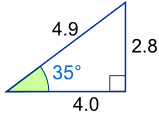
sin(35°) = Contrary / Hypotenuse
= 2.eight/4.9
= 0.57...
sin-ane(Contrary / Hypotenuse) = sin-ane(0.57...)
= 35°
And now for the details:
Sine, Cosine and Tangent are all based on a Right-Angled Triangle
They are very like functions ... and then we will look at the Sine Part so Inverse Sine to learn what it is all about.
Sine Function

The Sine of angle θ is:
- the length of the side Opposite angle θ
- divided past the length of the Hypotenuse
Or more just:
sin(θ) = Contrary / Hypotenuse
Case: What is the sine of 35°?
 | Using this triangle (lengths are only to one decimal place): sin(35°) = Opposite / Hypotenuse |
The Sine Function can help us solve things like this:
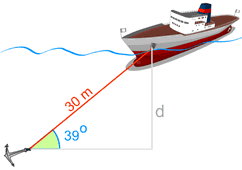
Example: Use the sine function to find "d"
We know
- The bending the cable makes with the seabed is 39°
- The cable'south length is thirty thou.
And nosotros want to know "d" (the distance down).
Starting time with: sin 39° = reverse/hypotenuse
sin 39° = d/xxx
Bandy Sides: d/xxx = sin 39°
Use a calculator to observe sin 39°: d/30 = 0.6293…
Multiply both sides past 30: d = 0.6293… x 30
d = eighteen.88 to 2 decimal places
The depth "d" is 18.88 m
Inverse Sine Role
Simply sometimes information technology is the angle we need to notice.
This is where "Inverse Sine" comes in.
It answers the question "what angle has sine equal to opposite/hypotenuse?"
The symbol for inverse sine is sin-one , or sometimes arcsin.
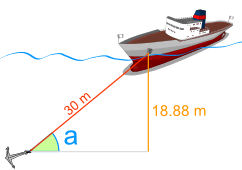
Case: Notice the bending "a"
We know
- The altitude down is 18.88 grand.
- The cable's length is 30 m.
And we desire to know the angle "a"
Commencement with: sin a° = opposite/hypotenuse
sin a° = eighteen.88/30
Calculate 18.88/30: sin a° = 0.6293...
What bending has sine equal to 0.6293...?
The Changed Sine will tell us.
Inverse Sine: a° = sin−1 (0.6293...)
Use a calculator to find sin−1 (0.6293...): a° = 39.0° (to ane decimal place)
The angle "a" is 39.0°
They Are Like Forrad and Backwards!

- sin takes an bending and gives us the ratio "reverse/hypotenuse"
- sin-1 takes the ratio "opposite/hypotenuse" and gives u.s. the angle.
Example:
Sine Office: sin(30°) = 0.5
Changed Sine: sin−1(0.5) = thirty°
Reckoner
 | On the calculator you press ane of the following (depending on your brand of calculator): either '2ndF sin' or 'shift sin'. |
On your calculator, effort using sin and and so sin-1 to see what happens
More Than I Angle!
Inverse Sine simply shows you i angle ... but in that location are more angles that could work.
Case: Here are two angles where opposite/hypotenuse = 0.v

In fact there are infinitely many angles, because y'all can keep adding (or subtracting) 360°:

Recollect this, because there are times when you actually need one of the other angles!
Summary

The Sine of angle θ is:
sin(θ) = Opposite / Hypotenuse
And Changed Sine is :
sin-1 (Opposite / Hypotenuse) = θ
What Almost "cos" and "tan" ... ?
Exactly the same idea, only different side ratios.
Cosine

The Cosine of angle θ is:
cos(θ) = Next / Hypotenuse
And Changed Cosine is :
cos-i (Adjacent / Hypotenuse) = θ
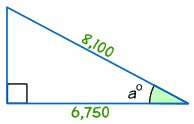
Instance: Detect the size of bending a°
cos a° = Adjacent / Hypotenuse
cos a° = 6,750/8,100 = 0.8333...
a° = cos-i (0.8333...) = 33.6° (to i decimal place)
Tangent

The Tangent of bending θ is:
tan(θ) = Opposite / Adjacent
So Changed Tangent is :
tan-1 (Contrary / Next) = θ
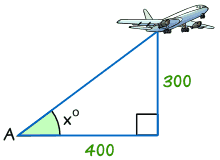
Example: Find the size of angle x°
tan x° = Opposite / Adjacent
tan x° = 300/400 = 0.75
x° = tan-1 (0.75) = 36.9° (correct to 1 decimal place)
Other Names
Sometimes sin-1 is chosen asin or arcsin
Likewise cos-1 is called acos or arccos
And tan-1 is called atan or arctan
Examples:
- arcsin(y) is the same every bit sin-i(y)
- atan(θ) is the same as tan-1(θ)
- etc.
The Graphs
And lastly, here are the graphs of Sine, Inverse Sine, Cosine and Inverse Cosine:

Sine

Inverse Sine

Cosine

Changed Cosine
Did you observe anything nearly the graphs?
- They look similar somehow, right?
- Just the Inverse Sine and Inverse Cosine don't "go on forever" like Sine and Cosine do ...
Let us wait at the case of Cosine.
Here is Cosine and Inverse Cosine plotted on the same graph:

Cosine and Inverse Cosine
They are mirror images (almost the diagonal)
Only why does Inverse Cosine get chopped off at top and bottom (the dots are not actually part of the function) ... ?
Because to be a function information technology can just give i answer
when we inquire "what is cos-1(x) ?"
Ane Reply or Infinitely Many Answers
But we saw earlier that at that place are infinitely many answers, and the dotted line on the graph shows this.
So yes in that location are infinitely many answers ...
... but imagine you blazon 0.5 into your estimator, press cos-1 and it gives you a never ending list of possible answers ...
So we have this rule that a role can merely give ane reply.
And then, by chopping information technology off similar that we get merely one answer, just nosotros should remember that at that place could be other answers.
Tangent and Inverse Tangent
And here is the tangent role and changed tangent. Can you run across how they are mirror images (about the diagonal) ...?

Tangent

Inverse Tangent
Sin To The Negative 1,
Source: https://www.mathsisfun.com/algebra/trig-inverse-sin-cos-tan.html
Posted by: taylorencell1939.blogspot.com


0 Response to "Sin To The Negative 1"
Post a Comment